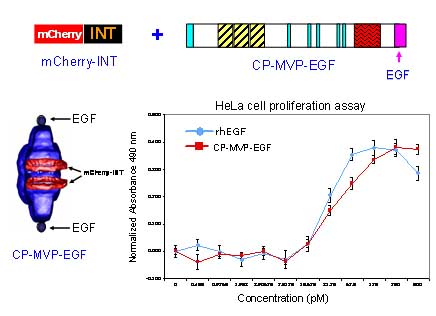Big Kids: Targeting Vaults to Cell Surface Receptors
Vaults have been engineered with externally-oriented peptides and protein domains to allow cell type specific targeting. This allows the particle to bind to receptors on the cell surface (Kickhoefer et al. ACS Nano 3, 27?36 (2009)). Three different tags have been engineered onto the major vault protein (MVP): an 11 amino acid tag derived from a virus (vesicular stomatitis virus (VSVG)), a 33 amino acid peptide that binds to antibodies (Z domain), and the 55 amino acids encoding a growth factor called epidermal growth factor (EGF). These modified vaults were produced using the baculovirus expression system. The figure below shows a schematic model for the EGF vault which was packaged with the red fluorescent protein, mCherry (produced as a fusion protein with the INT targeting domain). The vaults expressing EGF on their surface (called cp-MVP-EGF, see model) were tested for biological activity using a cell proliferation assay comparing equil amounts of recombinant human EGF (rhEGF) with the recombinant vaults displaying EGF. The results indicated that EGF attached to vaults was as biologically active as the recombinant human EGF.

The externally-oriented vault tags can be used to specifically bind the modified vaults to A431 epithelial cancer cells via the epidermal growth factor receptor (EGFR), either directly (EGF modified vaults) or as mediated by a monoclonal antibody (anti-EGFR) bound to recombinant vaults containing the Z peptide. The EGF modified vaults have the ability to specifically bind cell surface receptors and trigger receptor activation in a manner similar to recombinant human EGF. The ability to target vaults to specific cells represents an essential advance towards using recombinant vaults as delivery vehicles.